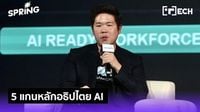In a rapidly evolving technological landscape, Siam AI Corporation is setting the stage for a new era of artificial intelligence (AI) in Thailand. At the recent seminar titled "AI Revolution 2025: A New Paradigm of New World Economy," Rattanapon Wongsenphachant, the Executive Director of Siam AI, emphasized the urgent need for Thailand to cultivate its own AI capabilities, specifically through the development of a Thai Large Language Model (ThaiLLM) and the emerging Vision-Language-Action (VLA) model.
Rattanapon articulated that establishing a sovereign AI framework is critical for the nation. He outlined five essential components that Thailand must develop to achieve this goal: an AI Factory, AI Models and Data, a robust AI Workforce, a supportive AI Ecosystem, and appropriate AI Imperatives tailored to the country’s unique context. These elements are crucial for fostering an independent AI identity that can effectively address local needs and challenges.
During his presentation, Rattanapon highlighted the limitations of existing large language models (LLMs) that are predominantly developed in foreign countries. He stated, "The LLMs used in Thailand are primarily sourced from China and the West, which often overlook the nuances of Thai culture and language. This lack of local context can lead to a disconnection from our identity. We must ensure that our AI reflects the intricacies of our society, preserving our cultural heritage and values."
This sentiment underscores the motivation behind the ThaiLLM initiative, which is designed to enhance the understanding of the Thai language and its cultural context. The ThaiLLM aims not only to provide accurate translations but also to serve as a deep reservoir of knowledge that resonates with the Thai identity. Rattanapon remarked, "ThaiLLM is not just about translation; it's about capturing the essence of our culture and wisdom, ensuring that our new generation remains connected to their roots."
As part of this effort, Siam AI is collaborating with NVIDIA to leverage advanced technologies. The company is currently utilizing the latest NVIDIA Grace Blackwell 200 GPU, which significantly boosts processing capabilities, equating to the computational power of 400,000 computers operating simultaneously. Looking ahead, Rattanapon expressed enthusiasm about upcoming advancements, noting that the Grace Blackwell 300 chip, expected to be released in mid-2025, will offer 1.5 times the performance of its predecessor. Furthermore, the Vera Rubin NVL 144 chip, anticipated in early 2026, promises to be three times faster than the Grace Blackwell 300. He stated, "These advancements will enable us to develop AI models that are not only faster but also more capable of understanding complex tasks and contexts."
Rattanapon also discussed the VLA model, which integrates vision, language, and action. He described VLA as a transformative approach to AI that will enhance the model's ability to process and understand information in a multifaceted manner. "The future of AI lies in its ability to see, understand, and act. VLA will be a game-changer in how we interact with technology, making it more intuitive and responsive to human needs," he explained.
During the seminar, Rattanapon shared insights from his recent participation in the GTC 2025 conference held by NVIDIA in San Jose, California, where discussions around Artificial General Intelligence (AGI) were prominent. He noted, "The conversations I had with various startups revealed a strong interest in AGI, which is poised to revolutionize our understanding of AI capabilities. AGI, which aims to replicate human cognitive functions, is not just a distant dream; it is becoming increasingly realistic."
Rattanapon's vision for Thai AI also emphasizes the importance of building an AI ecosystem that nurtures local talent and innovation. He pointed out that Thailand currently relies heavily on foreign LLMs, which often do not cater to the specific needs of Thai users. He stated, "If we want to build a robust AI infrastructure, we need to invest in our own AI factories and cultivate a workforce that is equipped to develop and manage these systems."
He further elaborated on the three methods for developing LLMs, indicating that while some organizations might choose to use existing services like DeepSeek from China, there are significant advantages to creating homegrown solutions. "Using foreign models may save costs in the short term, but it limits our potential to innovate and adapt to our unique cultural context. We need to prioritize building our own capabilities to ensure that our AI systems are truly reflective of our society," he added.
In conclusion, the drive towards establishing Thai AI through initiatives like ThaiLLM and VLA represents a pivotal step for the nation. By focusing on developing independent AI technologies, Thailand can safeguard its cultural identity while also harnessing the transformative power of AI to propel the country forward. As Rattanapon aptly summarized, "Building our own AI is not just about technology; it's about preserving our identity and ensuring that the future of Thailand is shaped by its people, for its people."





